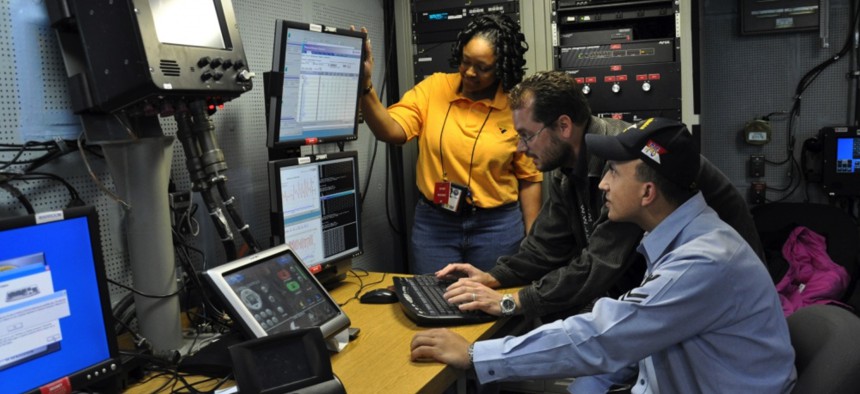
Troubleshooting the video teleconference system of a video information exchange system aboard the aircraft carrier USS Ronald Reagan in 2019. U.S. Navy / Rick Naystatt
A Navy 'Cattle Drive' Has Saved $150M in IT Costs
The service's two-year-old effort to consolidate computer systems is to be duplicated across the Pentagon.
The U.S. Navy has saved $150 million so far with its effort to consolidate IT systems, according to a top tech official. And the hope is to bump that up even more money as the Navy ramps up the initiative by 2025.
"We've achieved over $150 million in savings over the [future years defense program] in our Cattle Drive efforts that have been reinvested back into the HR and finance portfolios," Michael Galbraith, the Navy's chief digital innovation officer, said during the service's IT conference on May 23.
That progress is the result of "things that we kicked off two years ago" and "now folks are being recognized for that work because we're delivering," Galbraith said, noting how personnel received excellence awards for their IT accomplishments during the event.
The Navy launched its Cattle Drive effort to reduce the number of duplicative systems in 2020. The idea caught on and sparked consideration of a Defense Department-wide effort, which later made its way into the latest annual defense policy bill.
According to the 2022 National Defense Authorization Act, military service secretaries must "initiate efforts to identify legacy applications, software, and information technology within their respective Departments and eliminate any such application, software, or information technology that is no longer required."
Documentation, which includes identifying the technologies and funding sources plus a plan to discontinue use, is due in September, according to the provision on legacy IT and systems accountability. A separate provision directs the defense secretary to map out a plan for consolidating IT systems related to the planning, programming, budgeting and execution process.
Tom Sasala, the Navy's chief data officer, said Cattle Drive and Supernova, a complementary initiative that focused on the data emanating from the Navy's systems, have since been merged and his office, which resides under the chief information officer, recently began assessing the service's business enterprise architecture and defense business systems.
"The goal of Cattle Drive is to assess all solutions for form and fit, and then make deduplication recommendations where possible," Sasala told FCW.
"However, we are starting with business systems and infrastructure systems, so the work is not targeting all 1,800 registered systems. Eventually we will move on to weapons systems and intelligence systems."
Of those systems being evaluated, Sasala said, "a very small number of systems have the originating data" and others have copies of that data that were made and disseminated in some way. The challenge is identifying all data sources, whether originating or not, and determining which ones have the highest quality because that will help determine whether a system is needed.
The goal this year is to create that comprehensive inventory that can then be used for analytics and start "turning things off" through a "deep rationalization" as early as 2023 with 2025 as the target date, Sasala said. There will also be a concerted effort to educate personnel.
Once that happens, more revenue will get freed up and then reinvested for system modernizations.
"That's the stuff that we're working on over the next 18 months to really drive significant financial management equities in the [program objective memorandum] cycle right now. So we're not quite there yet," Sasala said. "But we're better than we were."
So far, Sasala said, they've made some progress and have come up with preliminary recommendations.
"We have been able to demonstrate the duplication of business processes within many different systems. Generally, each organization has a system to perform a process rather than a single enterprise solution. In some cases, when we do have an enterprise solution, come commands do not leverage or have not been migrated yet," Sasala said via email.
"The BEA allows us very quickly to see the heat map of what systems we have, what processes they implement, and helps identify possible areas for process improvement and system consolidation."




